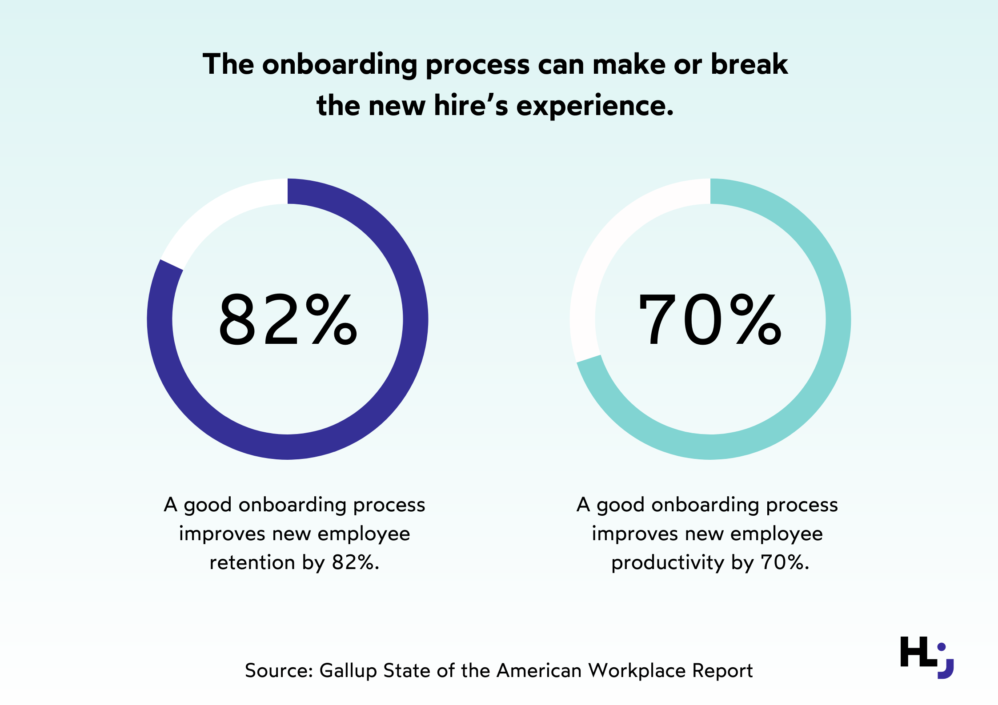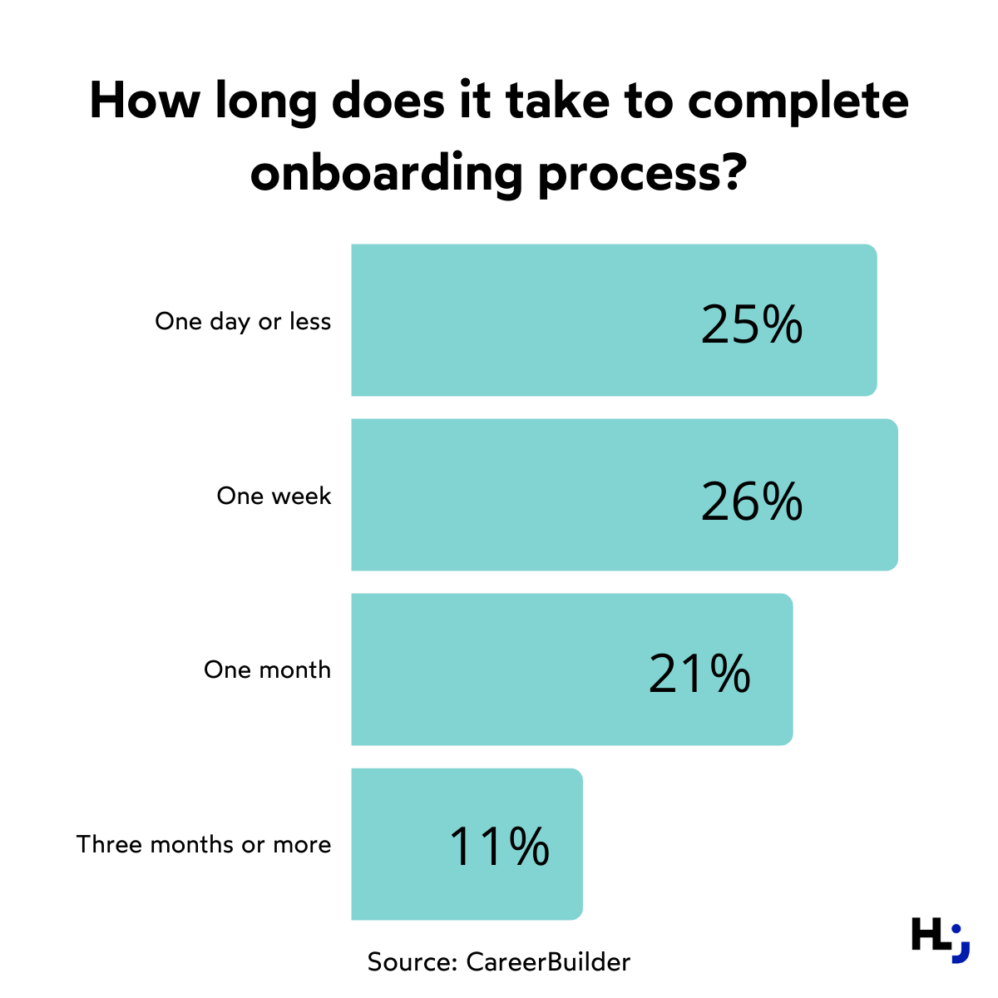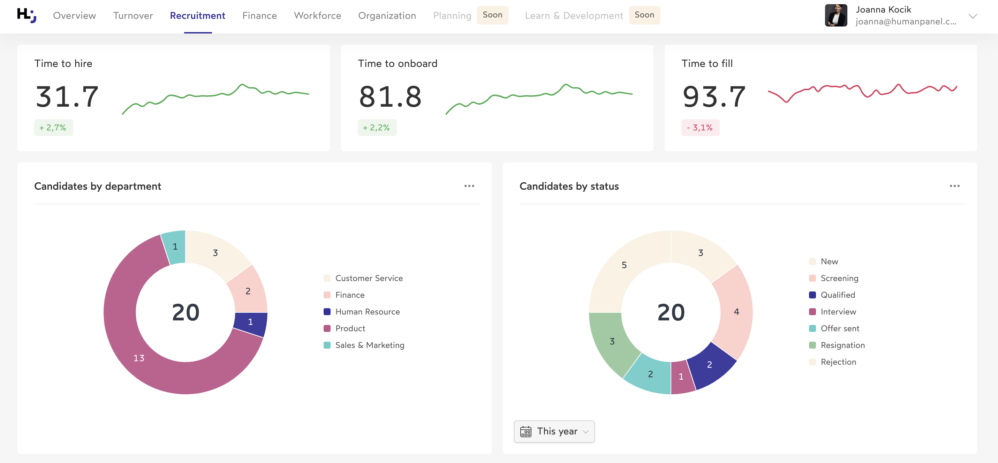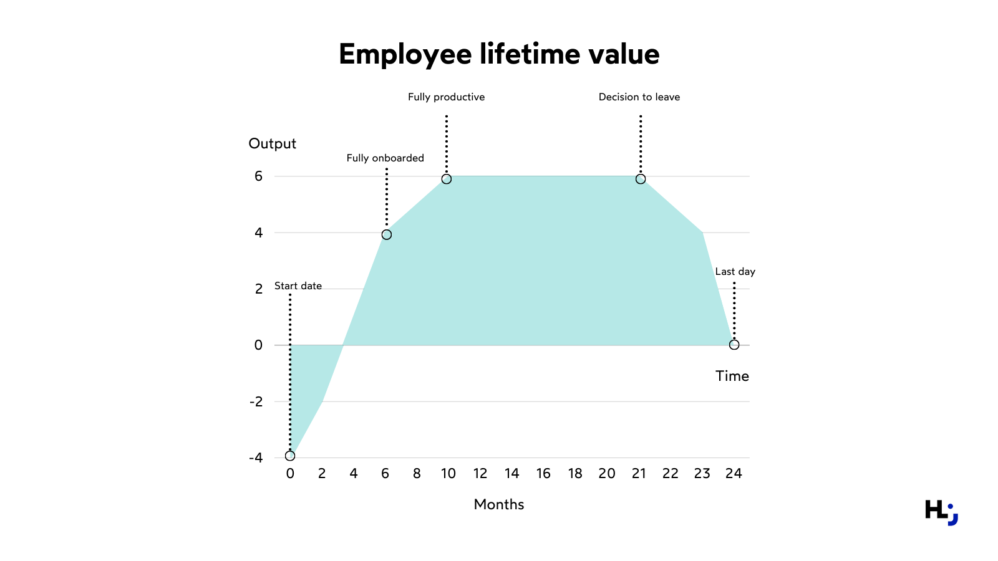How to structure onboarding to speed time to productivity

How long does it take for a new employee to become productive? What is an average onboarding time? We explain top employee onboarding statistics and facts.
Today, a well-structured onboarding process is key to successful hiring.When job openings are high, and unemployment is low, people can become very picky about where they want to work. That’s why it’s essential to engage and retain them from day one.
In this article, we present key onboarding statistics and facts that will help you structure your onboarding process. We also state what it takes to calculate new hire time to productivity. In other words – how long it takes for a new employee to become productive.
Table of contents:
- Why onboarding matters?
- How long should onboarding take?
- Onboarding statistics.
- Time to productivity – definition and formula.
- 7 tips from Human Panel CEO to improve time to productivity.
Why onboarding matters?
In today’s market, attracting and retaining talent is as challenging as ever. To get the best employees, companies need to offer them more than a competitive salary. They need to provide them with a unique work experience. The moment a candidate accepts the offer is critical, but what comes after is even more important. That’s why today, a well-structured onboarding process is key to successful hiring.
The onboarding process can make or break the new hire’s experience. A study by Gallup shows that companies with a good onboarding process improve new employee retention by 82% and productivity by over 70%.
The same study reveals that employees with good onboarding experience are 18 times more committed to their employer.
New hire turnover results from poor onboarding experience
Research also shows that a new employee’s decision to stay with a company long-term is made within the first six months of employment. If you use people analytics software, you can monitor the turnover of new employees. A high turnover rate within the first six months indicates that your onboarding process may need improvement.
Elevate data shows that about 20% of employees leave within the first 45 days of employment.
That costs money, because every new employee who quits means additional costs to hire and onboard a new employee. And there are other costs as well. In the U.S. and U.K. alone, about $37 billion is spent annually to keep unproductive employees who do not understand their jobs.
According to Digitate, a negative onboarding experience makes new employees twice as likely to look for other opportunities. And a survey of more than 500 experienced managers conducted by Egon Zehnder found that new hires struggled most with the company’s policies and culture. They didn’t understand “the rules of the game” and failed to build crucial relationships within their teams. This is why you should have a very well-thought-out onboarding process – as much as 20% of staff turnover occurs within the first 45 days of employment.

How long should onboarding take?
If you Google “How long should onboarding take”, you’ll probably get an answer that onboarding should take around 90 days. It is not necessarily true and we’ll discuss what to do to shorten onboarding time later in the article. But first, why everyone talks about those 90 days?
The three month onboarding time comes from the best-selling book “The First 90 Days,” by Michael Watkins, who wrote that the most significant impact you’ll ever have on new employees occurs during their first few months at the company. Those 90 days are likely the maximum amount of positive energy and attitude you’ll get from the employee, and that’s why you should have a very well-thought-out onboarding process.
At the same time, a Gallup study shows that only 12% of employees admit that their company has a robust onboarding process. HCI data shows that 58% of companies say their onboarding focuses on one week of paperwork.

Onboarding statistics
So, how long does it take on average to onboard a new employee? CareerBuilder completed a study that included 2300 hiring managers and found these results:

We’re a bit sceptical about these onboarding statistics, as it depends on how we define “onboarding”. The companies that claim to onboard people in one day are rather just doing “orientation”, which is just a phase of the onboarding process. Usually, orientation begins on the new employee’s first day and can last up to a week.
This is the time to discuss company policies regarding time off, health insurance, payroll, attendance, and benefits. If you work in an office, you might also like to share some practical knowledge with the new hires, such as spots for lunch or parking places.
1-2 months is considered to be the norm to get an employee completely onboarded.
To calculate average time to onboard in your organization, you can count the number of days between the candidate’s acceptance of your offer and the time a new employee begins to make a meaningful contribution.
If you’re using a people analytics solution, such as the Human Panel platform, you can track not only time to onboard but other recruitment metrics as well, such as time to hire, time to fill, new hire turnover rate or productivity.
Here’s an example of the Human Panel Recruitment Dashboard – if you want to discover more about the Human Panel features and metrics, click here.

Download our Recruiting Metrics PDF
New hire time to productivity
In your research about onboarding, you’ve probably came across another metric – time to productivity. It is not the same as time to onboard. An onboarded employee is the one making meaningful contribution and still has potential to reach full productivity. Time to productivity measures how long it takes for employees to become operational and productive. It is the time between the first day of hire and when the employee is contributing fully to the organization and reaching full productivity.
Time to productivity is an important metric – the shorter the time-to-productivity, the less it will cost your company. Therefore, it’s an HR metric you should track if you want to optimize the costs of your recruitment and onboarding processes.
Typically, it takes from five eight months for a newly hired employee to reach full productivity, according to various sources.
In this graphic, you can see the lifecycle of an employee. When an employee is fully onboarded, they still have potential to reach their full productivity.

Time to productivity formula
Unfortunately, there is no universal formula for time to productivity, as this metric is much more complex than calculating sales or time-to-employment. To accurately calculate time to productivity, you need to correlate data points such as time to hire, employee performance, and productivity.
However, you can measure the time to productivity of your new hires with a dedicated workforce analytics tool. If you have not used such a tool before, you can sign up for a free demo at Human Panel. You’ll see what you need to find out how long it takes your new hires to be productive, and how productive your new hires are.
Learn your new hires time to productivity
Discover all Human Panel features
Time to productivity – how to speed it up?
“Remember that time-to-productivity will vary greatly by position and industry,” comments Daniel Aduszkiewicz, CEO & Co-Founder of Human Panel.
Aduszkiewicz emphasizes that you should not use “opinions” as a data metric. “Building a workforce on opinions is a dead end. Measurable data will help you address the problem you have, whether it’s higher turnover or fighting the competition. Without data, you’ll have endless conversations that won’t lead to improving employee performance,” adds Daniel Aduszkiewicz.
Read also: time to hire vs time to fill – what’s the difference?
Structure your onboarding to improve time-to-productivity
So how to get your employees up to speed and improve your onboarding process? Here are 7 tips from Human Panel’s CEO:
1. Break onboarding down into phases

Plan your onboarding program and break it down into clear phases.
Stage 1: Pre-Onboarding
Pre-Onboarding begins as soon as a candidate accepts an offer and lasts until the first day of work.
This is the time when you set up the necessary tools and prepare relevant documents, do the paperwork, or help the candidate relocate for the job.
Do not underestimate this phase, because it happens that people change their decision even though they accepted the offer. Communication is key here: stay in touch with your new employee and offer them any support they need.
Stage 2: Welcome
The welcome phase can last a couple of hours, one day or even a few days, depending on the company.
This is the time to make a new employee feel welcome to your company and help them gain a general understanding of your company culture and practices.
Try to keep it as simple as possible and get a new employee involved in the first few days.
Stage 3: Orientation
Orientation can begin on the new employee’s first day.
This is the time to discuss company policies regarding time off, health insurance, payroll, attendance, and benefits. If you work in an office, you might also like to share some practical knowledge with the new hires, such as spots for lunch or parking places.
Stage 4: Training
This is the most crucial part of the onboarding process and is directly related to how a new employee will perform their job.
Spending time and resources teaching a new employee their tasks and responsibilities will help them start performing faster and become a full-fledged employee.
To succeed at each stage, you should define how long it will take, what impression you want to leave with the new employee, and how and when you will gather feedback.
2. Connect new employees with key stakeholders
It is the critical part of the onboarding process and it should take place during the orientation phase – explaining how your organization works, who’s who, and what the roles and responsibilities of the managers are that your employee will be working with.
It happens that people without elaborate job titles are crucial to the organization. Or, on the contrary, the organization has a highly complex structure of job titles that can be very confusing. Your new hire should know who the decisive stakeholders are to be successful on the job.
Ensure they know why these people are essential and how to connect with them. Knowing who the CFO or CTO is is good, but understanding who does what and why is even better.
Read also: Which HR metrics matter in recruitment and why?
3. Explain the corporate language
It’s equally important to familiarize a new employee with your company’s language. It may seem obvious, but every single organization has its specific jargon or a set of acronyms that are incomprehensible to outsiders.
New employees may feel embarrassed if they have to ask what something means that they hear all the time, so try to stay ahead of those questions. It’s better to prepare a company glossary than to have a new person spend two weeks figuring out a specific acronym.
In this context, it can be helpful to explain the language of the company and the tone of voice. All of this may seem like a small thing, but it can get the best out of your new employees in the quickest way possible.
4. Give them a buddy
According to HCI, 87% of companies say buddy programs improve the skills of new employees (although less than half have them). Dedicating a few hours of work from an experienced employee can significantly speed up the onboarding process.
Plus, the only cost you’ll incur is your expert’s time – but the point isn’t to have a newbie and an experienced employee working together all the time. Instead, schedule regular meetings of the two. Once a week for the first month and 1-2 times a month after that is a reasonable choice.
A buddy can also serve as a guide for the new employee, providing him or her with the general context of the company and introducing the person to the company’s social life.
5. Set clear expectations
From day one, communicate the tasks and expectations you have for your new employee. Define responsibilities and boundaries in terms of authority or available resources they should know. Outline where their autonomy begins and ends – this will help you avoid misunderstandings.
Schedule regular check-ins for feedback and discuss skill gaps. Don’t be discouraged if the onboarding period takes longer than what you expected. Some jobs require a lengthier adjustment period. Remember to ask new employees for their feedback – this can be valuable data, too.
6. Set as many productivity-oriented tasks as possible
For the first three months, assign your new employee as many productivity-oriented tasks as possible. Give them clear but realistic targets. Start with goals that you are confident that person can achieve. These early successes will help build confidence and gradually increase responsibility.
If you want your new employees to shine, provide them with training and learning opportunities. They can refer to both the basics of your business (the product) and your organization’s values.
Include numbers when evaluating the new hires’ performance and validate your evaluation with data. Do this in a safe environment and encourage employees to share their successes and areas of growth.
Read more about productivity statistics
7. Look into data
All your activities – including setting expectations and measuring progress – should be underpinned by data. These insights will suggest strategies and tactics that can be used in further onboarding phases, giving you a profile of your new employee.
If you work in a large company that hires thousands of employees, the data from such one-on-one interviews will give you a fantastic overview of your onboarding process as a whole. If you’re missing something, it’ll be on the record. Maybe you’re spending too much time explaining the toolset and not enough time focusing on the people around it?
In addition, data will show you how long it takes for a new person to reach the expected level of productivity. And it will arm you with arguments if you want to change the onboarding process. With some hard numbers, you’ll be able to really influence decision-making, not just put empty pressure on your superiors.
Remember that you first need to identify the problem you have to address it. Whether you’re struggling with poor employee retention, extended time-to-productivity, or high turnover, know your enemy. Creating processes or making changes based on your intuitions or insecurities can lead to significant money leaks, while you can access the powerful tool – the data.
If you want to effectively measure time to onboarding and time to productivity, Human Panel provides a dedicated HR management solution that will organize all your workforce data and help you optimize your processes. See how it works by requesting a free demo – all you need to do is fill out this short form below.




